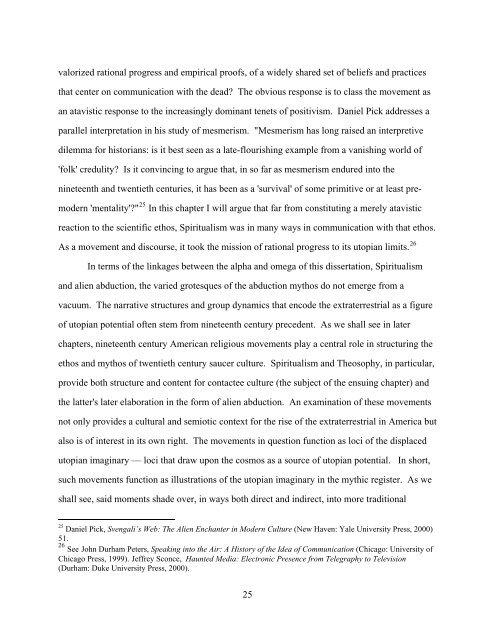A Genealogy of the Extraterrestrial in American Culture
A Genealogy of the Extraterrestrial in American Culture
A Genealogy of the Extraterrestrial in American Culture
Create successful ePaper yourself
Turn your PDF publications into a flip-book with our unique Google optimized e-Paper software.
valorized rational progress and empirical pro<strong>of</strong>s, <strong>of</strong> a widely shared set <strong>of</strong> beliefs and practices<br />
that center on communication with <strong>the</strong> dead? The obvious response is to class <strong>the</strong> movement as<br />
an atavistic response to <strong>the</strong> <strong>in</strong>creas<strong>in</strong>gly dom<strong>in</strong>ant tenets <strong>of</strong> positivism. Daniel Pick addresses a<br />
parallel <strong>in</strong>terpretation <strong>in</strong> his study <strong>of</strong> mesmerism. "Mesmerism has long raised an <strong>in</strong>terpretive<br />
dilemma for historians: is it best seen as a late-flourish<strong>in</strong>g example from a vanish<strong>in</strong>g world <strong>of</strong><br />
'folk' credulity? Is it conv<strong>in</strong>c<strong>in</strong>g to argue that, <strong>in</strong> so far as mesmerism endured <strong>in</strong>to <strong>the</strong><br />
n<strong>in</strong>eteenth and twentieth centuries, it has been as a 'survival' <strong>of</strong> some primitive or at least premodern<br />
'mentality'?" 25 In this chapter I will argue that far from constitut<strong>in</strong>g a merely atavistic<br />
reaction to <strong>the</strong> scientific ethos, Spiritualism was <strong>in</strong> many ways <strong>in</strong> communication with that ethos.<br />
As a movement and discourse, it took <strong>the</strong> mission <strong>of</strong> rational progress to its utopian limits. 26<br />
In terms <strong>of</strong> <strong>the</strong> l<strong>in</strong>kages between <strong>the</strong> alpha and omega <strong>of</strong> this dissertation, Spiritualism<br />
and alien abduction, <strong>the</strong> varied grotesques <strong>of</strong> <strong>the</strong> abduction mythos do not emerge from a<br />
vacuum. The narrative structures and group dynamics that encode <strong>the</strong> extraterrestrial as a figure<br />
<strong>of</strong> utopian potential <strong>of</strong>ten stem from n<strong>in</strong>eteenth century precedent. As we shall see <strong>in</strong> later<br />
chapters, n<strong>in</strong>eteenth century <strong>American</strong> religious movements play a central role <strong>in</strong> structur<strong>in</strong>g <strong>the</strong><br />
ethos and mythos <strong>of</strong> twentieth century saucer culture. Spiritualism and Theosophy, <strong>in</strong> particular,<br />
provide both structure and content for contactee culture (<strong>the</strong> subject <strong>of</strong> <strong>the</strong> ensu<strong>in</strong>g chapter) and<br />
<strong>the</strong> latter's later elaboration <strong>in</strong> <strong>the</strong> form <strong>of</strong> alien abduction. An exam<strong>in</strong>ation <strong>of</strong> <strong>the</strong>se movements<br />
not only provides a cultural and semiotic context for <strong>the</strong> rise <strong>of</strong> <strong>the</strong> extraterrestrial <strong>in</strong> America but<br />
also is <strong>of</strong> <strong>in</strong>terest <strong>in</strong> its own right. The movements <strong>in</strong> question function as loci <strong>of</strong> <strong>the</strong> displaced<br />
utopian imag<strong>in</strong>ary — loci that draw upon <strong>the</strong> cosmos as a source <strong>of</strong> utopian potential. In short,<br />
such movements function as illustrations <strong>of</strong> <strong>the</strong> utopian imag<strong>in</strong>ary <strong>in</strong> <strong>the</strong> mythic register. As we<br />
shall see, said moments shade over, <strong>in</strong> ways both direct and <strong>in</strong>direct, <strong>in</strong>to more traditional<br />
25 Daniel Pick, Svengali’s Web: The Alien Enchanter <strong>in</strong> Modern <strong>Culture</strong> (New Haven: Yale University Press, 2000)<br />
51.<br />
26 See John Durham Peters, Speak<strong>in</strong>g <strong>in</strong>to <strong>the</strong> Air: A History <strong>of</strong> <strong>the</strong> Idea <strong>of</strong> Communication (Chicago: University <strong>of</strong><br />
Chicago Press, 1999). Jeffrey Sconce, Haunted Media: Electronic Presence from Telegraphy to Television<br />
(Durham: Duke University Press, 2000).<br />
25















